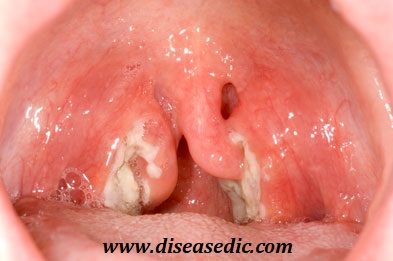Overview
Tonsillitis is inflammation of the tonsils, two oval-shaped pads of tissue at the back of the throat — one tonsil on each side. Signs and symptoms of tonsillitis include swollen tonsils, sore throat, difficulty swallowing and tender lymph nodes on the sides of the neck. Most cases of tonsillitis are caused by infection with a common virus, but bacterial infections also may cause tonsillitis.
Because appropriate treatment for tonsillitis depends on the cause, it’s important to get a prompt and accurate diagnosis. Surgery to remove tonsils, once a common procedure to treat tonsillitis, is usually performed only when bacterial tonsillitis occurs frequently, doesn’t respond to other treatments or causes serious complications.

Types of tonsillitis
There are different types of tonsillitis that are defined by their symptoms and recovery period.
These include:
- Acute tonsillitis: Symptoms usually last around 3 to 4 days but can last up to 2 weeks.
- Recurrent tonsillitis: A person has many different cases of acute tonsillitis in a year.
- Chronic tonsillitis: Individuals will have an ongoing sore throat and foul-smelling breath.
Causes of tonsillitis
Tonsils are your first line of defense against illness. They produce white blood cells to help your body fight infection. The tonsils combat bacteria and viruses that enter your body through your mouth. However, tonsils are also vulnerable to infection from these invaders.
Tonsillitis can be caused by a virus, such as the common cold, or by a bacterial infection, such as strep throat. According to the American Academy of Family Physicians (AAFP), an estimated 15 to 30 percent of tonsillitis cases are due to bacteria. Most often it’s strep bacteria.
Viruses are the most common cause of tonsillitis. The Epstein-Barr virus can cause tonsillitis, which can also cause mononucleosis.
Children come into close contact with others at school and play, exposing them to a variety of viruses and bacteria. This makes them particularly vulnerable to the germs that cause tonsillitis.
Risk factors of tonsillitis
Risk factors for tonsillitis involve increasing the risk of invasion by pathogenic viruses or bacteria.
- Living or working in close proximity to children
- Living in an urban environment with more exposure to viruses or bacteria
- Being a young child or elderly adult
- Being immunocompromised
- Living or working in close proximity to airborne pollutants, such as smoke
- Living in colder climates
- Suffering from diabetes
- Suffering from cardiac disease
- Excessive and prolonged use of corticosteroids
- Obesity or overweight
Signs and Symptoms of tonsillitis
The most common symptoms of tonsillitis include:
- A sore throat and pain when swallowing
- Red and swollen tonsils with pus-filled spots
- High temperature
- Headache
- Difficulty swallowing
- Pain in the ears and neck
- Tiredness
- Difficulty sleeping
- Coughing
- Chills
- Swollen lymph glands
Less common symptoms can include:
- Fatigue
- Stomach pain and vomiting
- Nausea
- Furry tongue
- Changes in the sound of the voice
- Bad breath
- Difficulty opening the mouth
In some cases, tonsilloliths, also known as tonsil stones or tonsillar calculi, may be present. A tonsillolith is a calcified build-up of material in the crevices of the tonsils.
They are generally small, but in rare cases, it have measured 3 centimeters and above.
Tonsilloliths can be a nuisance
Complications of tonsillitis
Complications of tonsillitis are rare and usually only occur if it’s caused by a bacterial infection. They’re usually the result of the infection spreading to another part of the body.
Possible complications of tonsillitis include:
- A middle ear infection (otitis media) – where fluid between the eardrum and inner ear becomes infected by bacteria
- Quinsy (peritonsillar abscess) – an abscess (collection of pus) that develops between one of the tonsils and the wall of the throat
- Obstructive sleep apnoea (OSA) – where the walls of the throat relax during sleep, which causes breathing difficulties and poor sleep
Other complications of tonsillitis are very rare and usually only occur if an underlying bacterial infection is left untreated. They include:
- Scarlet fever – a condition that causes a distinctive pink-red skin rash
- Rheumatic fever – this causes widespread inflammation throughout the body, leading to symptoms such as joint pain, rashes, and jerky body movements
- Glomerulonephritis – an infection (swelling) of the filters in the kidneys that can cause vomiting and a loss of appetite
How tonsillitis is diagnosed?
Your healthcare provider will ask about your health history and do a physical exam. To guide treatment, your provider may rub a sterile swab over the back of the throat and tonsils to get a sample of the secretions and perform:
- Rapid strep test: This test can detect strep bacteria in minutes
- Throat culture and sensitivity: The sample is cultured in a lab for the presence of bacteria; it helps the provider choose the best antibiotic to treat it, but can take 48 to 72 hours to get the results
Treatment and medications
A mild case of tonsillitis doesn’t necessarily require treatment, especially if a virus, such as a cold, causes it.
Treatments for more severe cases of this disease may include antibiotics or a tonsillectomy.
If a person becomes dehydrated due to tonsillitis, they may need intravenous fluids. Pain medicines to relieve the sore throat can also help while the throat is healing.
Tonsillectomy
Surgery to remove the tonsils is called a tonsillectomy. It’s generally only recommended for people who experience chronic or recurrent tonsillitis, or for cases where tonsillitis causes complications or symptoms don’t improve.
If you’ve had tonsillitis or strep throat at least 5 to 7 times in the past year, a tonsillectomy may help. The surgery can also relieve breathing problems or trouble swallowing that can result from tonsillitis.
A tonsillectomy may reduce the number of throat infections in children during the first year after surgery, according to a 2017 study. However, a 2018 studyTrusted Source found that adults who had their tonsils removed as children had increased risks of respiratory and infectious diseases long term.
Having a tonsillectomy may reduce your overall risk of developing strep throat. You can still get strep throat and other throat infections after your tonsils are removed, though. It’s also possible for your tonsils to grow back after surgery, but this is uncommon.
You should be able to go home the same day as your surgery, but it will take 1 to 2 weeks to fully recover. Learn what to do before and after getting a tonsillectomy.
Tonsillitis antibiotics
If a bacterial infection caused your tonsillitis, your doctor can prescribe antibiotics to fight the infection.
Antibiotics may help your symptoms go away slightly faster. However, they increase the risk of antibiotic resistance and may have other side effects, like an upset stomach. Antibiotics are more necessary for people at risk of complications from tonsillitis.
If your doctor prescribes you antibiotics, it’s likely to be penicillin for tonsillitis caused by group A streptococcus. Other antibiotics are available if you’re allergic to penicillin.
It’s important that you complete the full course of antibiotics. Even if your symptoms disappear entirely, the infection can get worse if you don’t take all of the medicine as prescribed. Your doctor may want you to schedule a follow-up visit to ensure that the medication was effective.
What natural or home remedies help soothe tonsillitis pain and inflammation?
If a doctor has diagnosed it, some home remedies can help soothe the symptoms of a sore throat.
- Throat sprays and lozenges: These can coat and moisturize the throat, and many have a topical anesthetic to relieve pain (consult a doctor before giving lozenges to young children; they can be a choking hazard)
- Saltwater gargle: This helps clear mucus from the throat
- Sipping warm beverages such as tea with honey, or broth can be soothing
- Eating cold foods such as ice cream or popsicles can help ease pain
Some alternative remedies may help ease tonsillitis symptoms.
- Slippery elm in lozenge form may help with pain relief
- Serrapeptase is an enzyme that has anti-inflammatory properties and can help decrease pain and help with swallowing
- Papain is an enzyme that can help treat inflammation
- Andrographis can help treat fever and sore throat symptoms
Consult your doctor before using any alternative remedies. Doctors do not recommend many of these home remedies for use in children or adolescents as most have not been scientifically evaluated.
Prevention
The germs that cause viral and bacterial tonsillitis are contagious. Therefore, the best prevention is to practice good hygiene. Teach your child to:
- Wash his or her hands thoroughly and frequently, especially after using the toilet and before eating
- Avoid sharing food, drinking glasses, water bottles or utensils
- Replace his or her toothbrush after being diagnosed with tonsillitis
To help your child prevent the spread of a bacterial or viral infection to others:
- Keep your child at home when he or she is ill
- Ask your doctor when it’s all right for your child to return to school
- Teach your child to cough or sneeze into a tissue or, when necessary, into his or her elbow
- Teach your child to wash his or her hands after sneezing or coughing
 Diseases Treatments Dictionary This is complete solution to read all diseases treatments Which covers Prevention, Causes, Symptoms, Medical Terms, Drugs, Prescription, Natural Remedies with cures and Treatments. Most of the common diseases were listed in names, split with categories.
Diseases Treatments Dictionary This is complete solution to read all diseases treatments Which covers Prevention, Causes, Symptoms, Medical Terms, Drugs, Prescription, Natural Remedies with cures and Treatments. Most of the common diseases were listed in names, split with categories.








medicine for tonsil
please read in the comment section.
whats the medication for tonsil. it has been my nightmare seriously. I need help
amoxicillin
Amoxil
Azithromycin Dose Pack
azithromycin
Zithromax
Chloraseptic Sore Throat Spray
is surgery the only option
Usually, the surgery is a treatment option for those who are often sick with tonsillitis.
what kind of antibiotics can be suitable for this. thanks
Penicillin taken by mouth for 10 days is the most common antibiotic treatment prescribed for tonsillitis caused by group A streptococcus.
which food we need to take to avoid tonsillitis
Introduce soft, bland foods such as pudding, applesauce or yogurt. Creamy substances are easy to swallow without much pain. Slowly introduce more food as your sore throat begins to improve. Baked fruit and vegetables, such as baked apples, baked pears and roasted carrots are good choices for side items. Mashed potatoes, winter squash, plain pasta and rice are also ideal soft foods. In addition, soups that contain vegetables, pasta, and/or soft pieces of meat are a healthy choice for patients with tonsillitis.
my son do have something like that always there by making him run temperature
If the tonsilitis infection reaches the bloodstream it recurs. Hence in your son’s case, we strongly recommend consulting a doctor for appropriate treatment.
What is the name given to the drug used to pour at the back of the mouth for a patient with tonsilitis
Penicillin taken by mouth for 10 days is the most common antibiotic treatment prescribed for tonsillitis caused by group A streptococcus. If your child is allergic to penicillin, your doctor will prescribe an alternative antibiotic.
What’s the Medication for Viral Tonsillitis?
Take an over-the-counter pain reliever such as acetaminophen or ibuprofen.
what type of medicine should I take for tonsillitis with pharyngitis.
The following list of medications are in some way related to, or used in the treatment of this condition
– amoxicillin
– azithromycin
– cefuroxime
– Zithromax
– cefixime
However, before taking these medicines, we request you to consult a doctor to get the prescribed medicines.
I am having only one problem with this,which is proper treatment.Please add proper treatment in it.
please read it in the treatment section.
plz send to.management of various tonsillitis
please read the natural home remedies here https://diseasesdic.com/tonsillitis-pathophysiology-complications-and-diagnosis/
Are there some management for chronic tonsillitis?
The management of chronic tonsillitis involves antibiotics for bacterial infections, pain relief with medications like acetaminophen or ibuprofen, warm salt gargles to soothe the throat, and staying well-hydrated. Adequate rest is important for recovery. In persistent cases, surgical intervention, such as tonsillectomy, may be considered, and consultation with an ENT specialist or healthcare professional is advisable for a personalized management plan.
what is the best treatment for tonsillitis
Please have a glance at the post for treatment details.